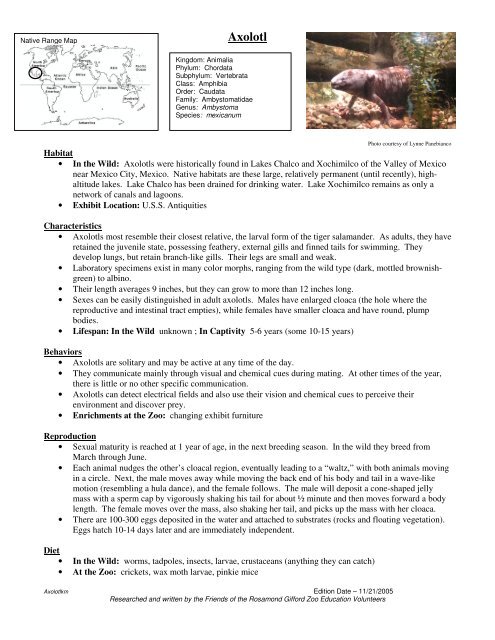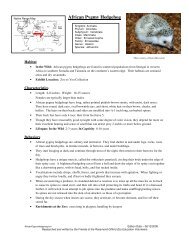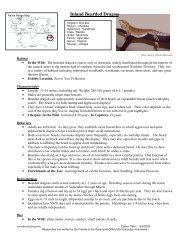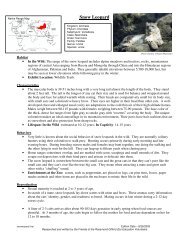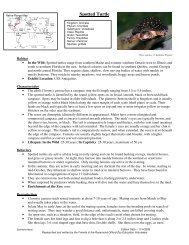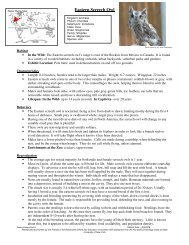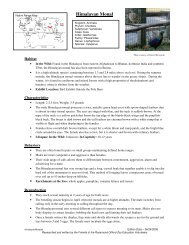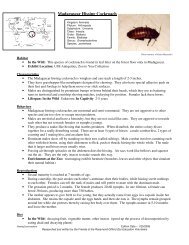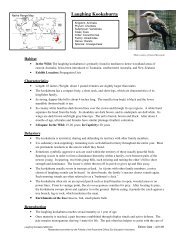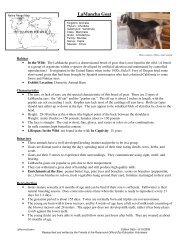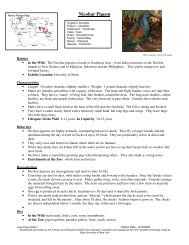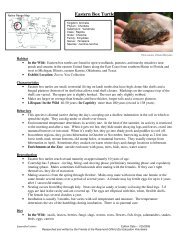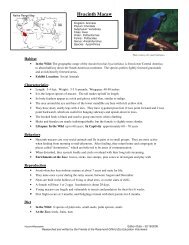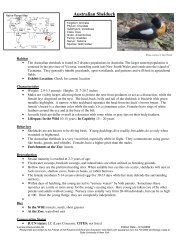Axolotl - Rosamond Gifford Zoo
Axolotl - Rosamond Gifford Zoo
Axolotl - Rosamond Gifford Zoo
Create successful ePaper yourself
Turn your PDF publications into a flip-book with our unique Google optimized e-Paper software.
Native Range Map<br />
<strong>Axolotl</strong><br />
Kingdom: Animalia<br />
Phylum: Chordata<br />
Subphylum: Vertebrata<br />
Class: Amphibia<br />
Order: Caudata<br />
Family: Ambystomatidae<br />
Genus: Ambystoma<br />
Species: mexicanum<br />
<strong>Axolotl</strong>km Edition Date – 11/21/2005<br />
Researched and written by the Friends of the <strong>Rosamond</strong> <strong>Gifford</strong> <strong>Zoo</strong> Education Volunteers<br />
Photo courtesy of Lynne Panebianco<br />
Habitat<br />
• In the Wild: <strong>Axolotl</strong>s were historically found in Lakes Chalco and Xochimilco of the Valley of Mexico<br />
near Mexico City, Mexico. Native habitats are these large, relatively permanent (until recently), highaltitude<br />
lakes. Lake Chalco has been drained for drinking water. Lake Xochimilco remains as only a<br />
network of canals and lagoons.<br />
• Exhibit Location: U.S.S. Antiquities<br />
Characteristics<br />
• <strong>Axolotl</strong>s most resemble their closest relative, the larval form of the tiger salamander. As adults, they have<br />
retained the juvenile state, possessing feathery, external gills and finned tails for swimming. They<br />
develop lungs, but retain branch-like gills. Their legs are small and weak.<br />
• Laboratory specimens exist in many color morphs, ranging from the wild type (dark, mottled brownishgreen)<br />
to albino.<br />
• Their length averages 9 inches, but they can grow to more than 12 inches long.<br />
• Sexes can be easily distinguished in adult axolotls. Males have enlarged cloaca (the hole where the<br />
reproductive and intestinal tract empties), while females have smaller cloaca and have round, plump<br />
bodies.<br />
• Lifespan: In the Wild unknown ; In Captivity 5-6 years (some 10-15 years)<br />
Behaviors<br />
• <strong>Axolotl</strong>s are solitary and may be active at any time of the day.<br />
• They communicate mainly through visual and chemical cues during mating. At other times of the year,<br />
there is little or no other specific communication.<br />
• <strong>Axolotl</strong>s can detect electrical fields and also use their vision and chemical cues to perceive their<br />
environment and discover prey.<br />
• Enrichments at the <strong>Zoo</strong>: changing exhibit furniture<br />
Reproduction<br />
• Sexual maturity is reached at 1 year of age, in the next breeding season. In the wild they breed from<br />
March through June.<br />
• Each animal nudges the other’s cloacal region, eventually leading to a “waltz,” with both animals moving<br />
in a circle. Next, the male moves away while moving the back end of his body and tail in a wave-like<br />
motion (resembling a hula dance), and the female follows. The male will deposit a cone-shaped jelly<br />
mass with a sperm cap by vigorously shaking his tail for about ½ minute and then moves forward a body<br />
length. The female moves over the mass, also shaking her tail, and picks up the mass with her cloaca.<br />
• There are 100-300 eggs deposited in the water and attached to substrates (rocks and floating vegetation).<br />
Eggs hatch 10-14 days later and are immediately independent.<br />
Diet<br />
• In the Wild: worms, tadpoles, insects, larvae, crustaceans (anything they can catch)<br />
• At the <strong>Zoo</strong>: crickets, wax moth larvae, pinkie mice
Conservation Status<br />
• IUCN status: Vulnerable; CITES: Appendix II<br />
• Virtually nothing is known about its ecology, natural history, or its relationship with other ambystomids.<br />
• <strong>Axolotl</strong>s are being threatened toward extinction in their native habitat by pollution, exploitation,<br />
agricultural development, draining and filling of lakes, and introduction of predators. Wild axolotls are<br />
becoming so scarce that permits are required for the possession and taking of a wild specimen.<br />
• Predators: sports fish<br />
Did You Know/Fun Facts<br />
• <strong>Axolotl</strong>s are salamanders. Ambystoma mexicanum is the species found in labs and as pets, but other<br />
species exist within the genus.<br />
• Until recently, axolotls were sold as food at markets. They have also been used for medicinal purposes as<br />
cures for colds and respiratory ailments.<br />
• <strong>Axolotl</strong> is derived from the language of the Aztecs (Nahuatl). Xolotl is an ancient god and twin brother<br />
of the Aztec god Quetzalcoatl. He has also been known as the God of Games.<br />
• <strong>Axolotl</strong>s are important research animals and have been used in studies of the regulation of gene<br />
expression, embryology, neurobiology, and regeneration.<br />
• Occasionally taken as a food item (a substitute for fish), axolotls are prepared by either roasting or<br />
boiling, and the tail is eaten with vinegar or cayenne pepper.<br />
• They can be aggressive towards one another and will bite off each other’s gills, feet, and tails (body parts<br />
will regenerate).<br />
Sources:<br />
• Eng, C. (1997). What is an axolotl. Retrieved Oct. 28, 2005, from Geocities Web site:<br />
http://www.geocities.com/Yosemite/4301/axolotlwhat.htm.<br />
• Majchrzak, A. 2004. Ambystoma mexicanum” (On-line), Animal Diversity Web. Accessed October 28,<br />
2005 at http:animaldiversity.ummz.umich.edu/site/accounts/information/Ambystoma_mexicanum.html.<br />
• Sedgwick County <strong>Zoo</strong>, 2005. <strong>Axolotl</strong>. Retrieved Oct. 28, 2005, from Sedgwick County <strong>Zoo</strong> Web site:<br />
http://www.scz.org/animals/a/axolotl.html.<br />
<strong>Axolotl</strong>km Edition Date – 11/21/2005<br />
Researched and written by the Friends of the <strong>Rosamond</strong> <strong>Gifford</strong> <strong>Zoo</strong> Education Volunteers


